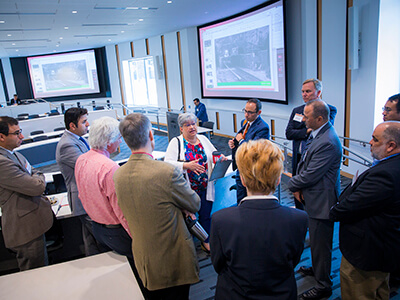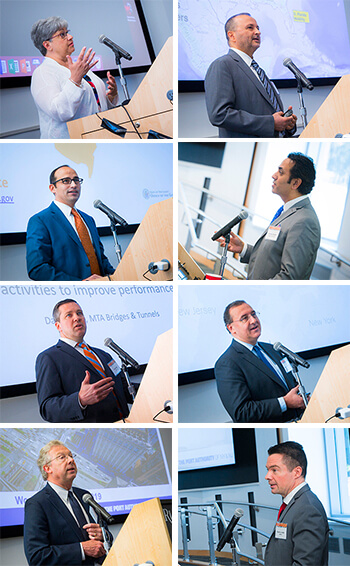
NJDOT Commissioner Diane Gutierrez-Scaccetti (center) engages attendees on a meeting break.
Producing implementable, real-world solutions for the region’s most pressing transportation infrastructure issues was the main topic at the USDOT Region 2 University Transportation Center (UTC) Partner Meeting on May 31.
As the Region 2 UTC lead institution, Rutgers CAIT gathered its consortium partners and high-level industry leaders to discuss the next round of UTC projects, agency clients’ priorities, and collaboration.
CAIT director Dr. Ali Maher, said that the meeting aimed to give the consortium more insight into their customers’ needs. UTC consortium partner universities are Atlantic Cape Community College, Columbia University, Cornell University, New Jersey Institute of Technology, Polytechnic University of Puerto Rico, Princeton University, Rowan University, Farmingdale State College, and University at Buffalo.
“It’s critical to have open communication with our stakeholders so that we can better identify their priorities and the problems they are facing,” Maher said. “CAIT works to solve the most acute operational transportation problems in the region. We need to understand what our customers are grappling with in order to develop applicable and appropriate remedies. By bringing everyone together, we were able to accomplish that.”
New Jersey Department of Transportation commissioner Diane Gutierrez-Scaccetti, was the first of many speakers to address the group of about 100 attendees. She said it is essential that stakeholders and researchers keep an open mind when problem solving.
“I think the most important thing that we can do in terms of changing our message, is to not refer to new technology as disruptive … it’s not disruptive, it’s transformative,” Gutierrez-Scaccetti told the group.

Speakers at the UTC partner meeting (left to right, top to bottom: Diane Gutierrez-Scaccetti (NJDOT); Ali Maher (CAIT); Vinn White (Office of the Governor); Prabhas Moghe (Rutgers Research & Innovation); David Kraft (MTA); Frank Sacr (Gateway Project Development Corp); Jim Starace (PANYNJ); Shawn Lenahan (PANYNJ). All photos ©Roy Groething/Rutgers CAIT.
Other than Commissioner Gutierrez-Scaccetti, several stakeholders shared their agency’s ongoing projects, gaps research could fill, and their agency’s longer-term goals.
Jim Starace, the Port Authority of New York and New Jersey’s chief engineer; Vinn White, senior transportation advisor for Governor Phil Murphy; and Francis Sacr, interim finance director of the Gateway Program Development Corporation, all offered their distinct insights. But a common theme they all touched on was the importance of adopting of new, transformative technology.
Speaking of transformative, the Innovation Hub that CAIT proposed to the New Jersey Economic Development Authority was a highlight of the meeting.
The Innovation Hub is envisioned as a living laboratory and smart-mobility testing ground in downtown New Brunswick. It will be equipped with a variety of sensors that will collect and process real-time, high-resolution mobility data from vehicles, pedestrians, and infrastructure in the city.
Gutierrez-Scaccetti said the project will lay important groundwork for autonomous vehicles. “As we continue to grow the transportation system, we’re going to have to do better than adding pavement,” she said. “So, we have to look at technology to solve that problem. And so, the Innovation Hub, as a living lab, will help us to collect the data needed to ensure that what we’re doing in New Brunswick can then be expanded.”
More information on the New Brunswick Innovation Hub appears in the July 2019 CAIT Update.
Maher reported that CAIT has 21 projects for this year of funding, and that the Innovation Hub is one key example of the kind of problem-solving CAIT’s researchers are engaged in. As the meeting continued, UTC partners shared plenty of other examples, updating the group on their active projects.
Civil engineering professor Dr. Frank Moon talked about regional perspectives and the importance of industry-academia partnerships. “There are journals that are filled with papers that, as far as I can tell, have almost no potential for application,” he said. “And so, by partnering with owners you’re at least assured that the problems you’re working on are real. And, if you do a good job and come up with something [novel and practical], it can actually have an impact in the field.”
At the end of the meeting, partners and stakeholders both left with a clearer picture of the top issues facing the region and new opportunities to work together.
Maher said that what was learned will help spark meaningful projects in the next several years. “We have massive amounts of infrastructure in our region, so being able to learn from the key people in charge of it was important,” he said. “I was happy to see that every UTC project mentioned had a key stakeholder involved. As we move forward, we’ll continue to emphasize innovative technology that solves the problems of our region.”
June 2019

